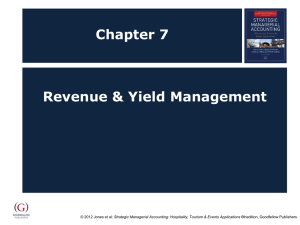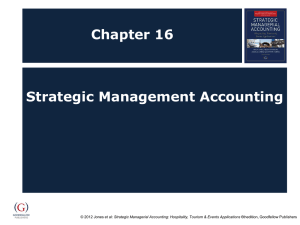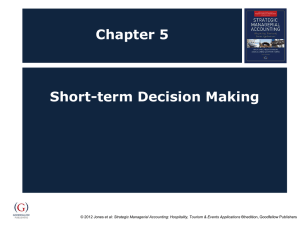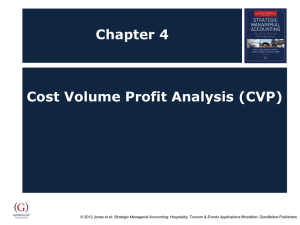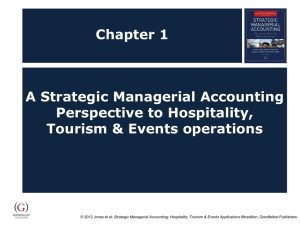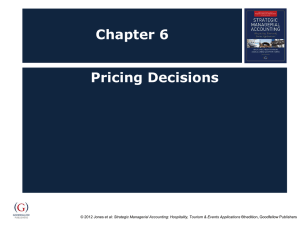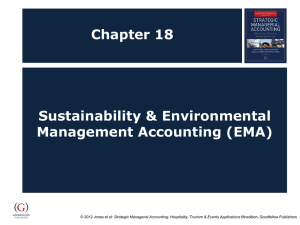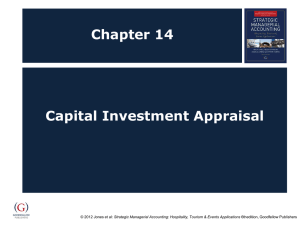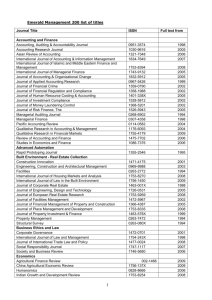Chapter 12
advertisement
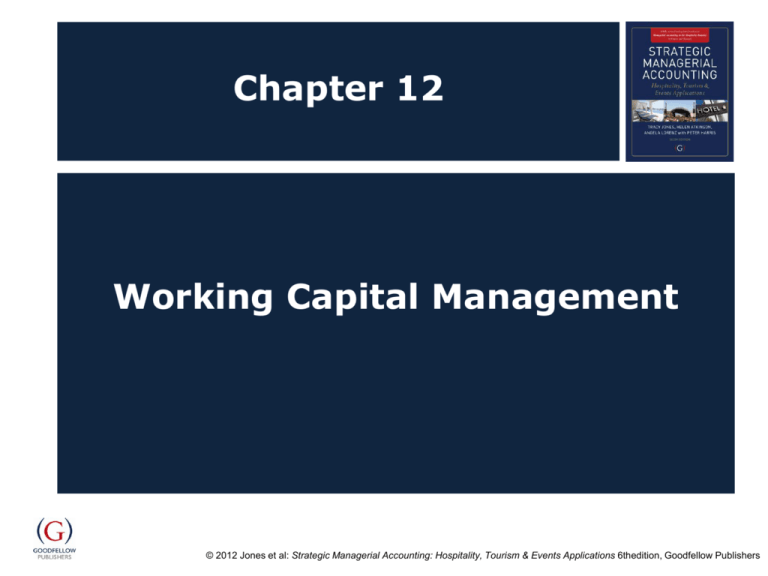
Chapter 12 Working Capital Management © 2012 Jones et al: Strategic Managerial Accounting: Hospitality, Tourism & Events Applications 6thedition, Goodfellow Publishers Objectives After studying this topic you should be able to: Understand the importance of working capital to the business Evaluate the different working capital policies that can be adapted by a firm Understand what the key components of working capital are Consider the working capital requirements of a firm with respect to inventory, accounts receivable, cash and accounts payable Establish sound policies for the efficient management and control of the key component elements © 2012 Jones et al: Strategic Managerial Accounting: Hospitality, Tourism & Events Applications 6thedition, Goodfellow Publishers The Working Capital Cycle Produce products/ services Buy inventory Sell products/ services Cash from customers Customers owes money © 2012 Jones et al: Strategic Managerial Accounting: Hospitality, Tourism & Events Applications 6thedition, Goodfellow Publishers Measuring Working Capital The working capital of a business can be easily measured by looking at its statement of financial position. It reflects the current assets minus the current liabilities. Money expected to flow in – money expected to flow out Working capital management is a matter of ensuring sufficient liquid resources (cash) are maintained this involves achieving a balance between the requirement to minimise the risk of insolvency (running out of cash) and the requirement to maximise the return on assets (be efficient with the cash). It is therefore important from two aspects liquidity and profitability. © 2012 Jones et al: Strategic Managerial Accounting: Hospitality, Tourism & Events Applications 6thedition, Goodfellow Publishers Working capital Policy The working capital policy is a function of two decisions within the organisation: The Investment decision – what do I need to buy? The Finance decision – where can I access the money? © 2012 Jones et al: Strategic Managerial Accounting: Hospitality, Tourism & Events Applications 6thedition, Goodfellow Publishers Matching Policy Fluctuating Current Assets Short-Term Financing Investment £000 Permanent Current Assets Long-Term Financing Non-Current Assets Time © 2012 Jones et al: Strategic Managerial Accounting: Hospitality, Tourism & Events Applications 6thedition, Goodfellow Publishers Conservative Policy Fluctuating Current Assets Short-Term Financing Investment £000 Permanent Current Assets Long-Term Financing Non-Current Assets Time © 2012 Jones et al: Strategic Managerial Accounting: Hospitality, Tourism & Events Applications 6thedition, Goodfellow Publishers Aggressive Policy Fluctuating Current Assets Short-Term Financing Investment £000 Permanent Current Assets Long-Term Financing Non-Current Assets Time © 2012 Jones et al: Strategic Managerial Accounting: Hospitality, Tourism & Events Applications 6thedition, Goodfellow Publishers Operational V Financial Imperatives Operational perspective Financial perspective The restaurant manager wants to ensure there is sufficient stock (inventory) in place to be able always offer the full menu and not run out of individual food items. The accountant wants money ‘tied up’ in Inventory to be kept to a minimum, so the resource is available to ‘work’ within the business. In order to gain contracts for an event or conference the event’s manager is willing to agree trade credit terms with the customer. The accountant wants to ensure the customer is ‘credit worthy’ and if credit terms are allowed there is a high chance they will be able to pay in the future and on time. The operations manager wants to have a good working relationship with their suppliers, so the suppliers will work with them when they need urgent extra supplies. Financially, paying suppliers as late as possible (without incurring penalties) makes financial sense. © 2012 Jones et al: Strategic Managerial Accounting: Hospitality, Tourism & Events Applications 6thedition, Goodfellow Publishers Working Capital Characteristics of Different Businesses Most businesses will have different working capital requirements because of three main areas: Holding inventory Time allowed for customers to pay Time taken to pay suppliers © 2012 Jones et al: Strategic Managerial Accounting: Hospitality, Tourism & Events Applications 6thedition, Goodfellow Publishers Management of Inventory Inventory Costs can be classified as: Holding Costs Procurement Costs Shortage Costs Cost of Inventory Itself © 2012 Jones et al: Strategic Managerial Accounting: Hospitality, Tourism & Events Applications 6thedition, Goodfellow Publishers Inventory Control Policy An inventory control policy should reflect the following four criteria: Keep total costs down (ideally to a minimum). Provide satisfactory service levels to customers. Ensure smooth-running production systems. Be able to withstand fluctuations in business conditions, e.g. changes in customer demand, prices, availability of raw materials, etc. © 2012 Jones et al: Strategic Managerial Accounting: Hospitality, Tourism & Events Applications 6thedition, Goodfellow Publishers Inventory Control Formulae Reorder level Maximum usage x maximum lead time Minimum level reorder level - (average usage x average lead time) Maximum level reorder level + reorder quantity - (minimum usage x minimum lead time) Average inventory safety inventory + 1/2 reorder quantity © 2012 Jones et al: Strategic Managerial Accounting: Hospitality, Tourism & Events Applications 6thedition, Goodfellow Publishers Economic Order Quantity (EOQ) 2 x C0 x D Ch Q= Where : D Co Ch = = = Q = demand cost of one order holding cost per inventory unit per annum quantity to be ordered © 2012 Jones et al: Strategic Managerial Accounting: Hospitality, Tourism & Events Applications 6thedition, Goodfellow Publishers Total Cost HOLDING COST + REORDERING COST Holding = Q x Ch 2 Reordering = D x Co Q © 2012 Jones et al: Strategic Managerial Accounting: Hospitality, Tourism & Events Applications 6thedition, Goodfellow Publishers Example Perfecto Pasta uses tomato puree on a regular basis throughout the year. The annual demand of the puree is 5400 kg and the cost of holding 1kg in terms of shelf and fridge space is £0.75. Records show that it costs £2.50 to place and process an order. © 2012 Jones et al: Strategic Managerial Accounting: Hospitality, Tourism & Events Applications 6thedition, Goodfellow Publishers Answer Using the EOQ formula = = 190kg This means that the most economical order size when both the holding and ordering costs are taken into account is 190kg per order. On this basis the company would make 5400𝑘𝑔 190𝑘𝑔 = 28.42 orders Which is the equivalent of one order every 13 days. © 2012 Jones et al: Strategic Managerial Accounting: Hospitality, Tourism & Events Applications 6thedition, Goodfellow Publishers Graph showing EOQ c o s t s nnual ost olding nnual ordering cost rder si e © 2012 Jones et al: Strategic Managerial Accounting: Hospitality, Tourism & Events Applications 6thedition, Goodfellow Publishers EOQ and discounts The EOQ formula may need to be modified if bulk discounts are available. It is necessary to minimise the total of: 1. total purchase costs 2. ordering costs 3. inventory holding costs The total cost will be minimised at the pre discount EOQ level so that the discount is not worthwhile or at the minimum order size necessary to earn the discount. © 2012 Jones et al: Strategic Managerial Accounting: Hospitality, Tourism & Events Applications 6thedition, Goodfellow Publishers Example (1) Perfecto Pasta regularly buys Prosecco from a local wholesaler. The cost of making an order has been estimated at £3.00 and the cost of holding a bottle in stock is 1.50, the annual purchase from the wholesaler has been 19,600 bottles at a price of £7 each. On this basis the economic order quantity for Perfecto has been 280 bottles per order. The wholesaler has now offered Perfecto a deal where if they order in batches 400 they can have a 1% discount per bottle. Is it beneficial for Perfecto to take the order and hold a greater number of units? © 2012 Jones et al: Strategic Managerial Accounting: Hospitality, Tourism & Events Applications 6thedition, Goodfellow Publishers Example (2) There are three elements to the cost: £ Purchase price £7 x 19600 bottles Holding cost 280/2 x 1.50 210 Ordering cost 19600/280 x 3 210 Total cost of ordering 280 bottles per order 137,200 137,620 New offer buy 400 bottles per order Purchase price £7x 0.99 x 19600 bottles Holding cost 400/2 x 1.50 300 Ordering cost 19600/400 x 3 147 Total cost of ordering 280 bottles per order 135,828 136,275 In this case it is better for Perfecto to accept the offer from the supplier as the saving on the purchase price outweighs additional holding cost. © 2012 Jones et al: Strategic Managerial Accounting: Hospitality, Tourism & Events Applications 6thedition, Goodfellow Publishers Managing Accounts Receivable Businesses of most types need to allow credit to achieve satisfactory sales. Allowing credit however, results in: 1. An interest cost of funds tied up in giving credit to customers 2. Possibility of bad debts (this occurs when customers do not pay the amount they owe) A balance has to be found between sales volume, credit allowed, interest costs and bad debts. © 2012 Jones et al: Strategic Managerial Accounting: Hospitality, Tourism & Events Applications 6thedition, Goodfellow Publishers The Credit Cycle The stages in the credit cycle are as follows: 1. 2. 3. 4. 5. 6. Receipt of customer order; Credit screening and agreement of terms; Goods dispatched or service provided with delivery note; Invoice raised stating credit terms; Debt collection procedures; Receipt of cash. © 2012 Jones et al: Strategic Managerial Accounting: Hospitality, Tourism & Events Applications 6thedition, Goodfellow Publishers Credit Control Management when formulating a credit control policy must consider the following factors: 1. 2. 3. 4. 5. Cost of managing accounts receivable Procedures for controlling credit Capital required to finance credit Credit terms and allowing discount for prompt payment Creditworthiness of customers © 2012 Jones et al: Strategic Managerial Accounting: Hospitality, Tourism & Events Applications 6thedition, Goodfellow Publishers Cost of managing accounts receivable Accounts receivable management as previously mentioned is about balancing the benefit of extending credit against the costs. The costs to be considered are: The opportunity cost of capital Cost of bad debts Cost of extending settlement discounts Administration costs of managing the credit control function. © 2012 Jones et al: Strategic Managerial Accounting: Hospitality, Tourism & Events Applications 6thedition, Goodfellow Publishers Assessing Creditworthiness 1. 2. 3. 4. 5. 6. 7. 8. Gather references at least two, one of which should be from the bank Check credit ratings Set credit limits and payment terms and review them regularly Review the files of clients Use internal sources such as reports from salespeople Utilise external information e.g. government, press Analyse their financial statements Visit the organisation © 2012 Jones et al: Strategic Managerial Accounting: Hospitality, Tourism & Events Applications 6thedition, Goodfellow Publishers Collecting debts (1) There are two stages in collecting debts the first involves efficient and prompt procedures for dealing with paperwork: Customers must be fully aware of the credit terms Invoices should be sent out immediately after delivery Checks should be carried out to ensure that invoices are accurate The investigation of any queries or complaints should be carried out promptly Monthly statements should be sent out early enough for them to be included in the customer’s monthly settlement of bills © 2012 Jones et al: Strategic Managerial Accounting: Hospitality, Tourism & Events Applications 6thedition, Goodfellow Publishers Collecting Debts (2) The second involves procedures for pursuing overdue debts: Reminders on final demands Chasing by telephone Making personal approaches Stopping credit Transfer of debt to specialist collection team Instituting legal action Transfer of debt to external debt collection agency © 2012 Jones et al: Strategic Managerial Accounting: Hospitality, Tourism & Events Applications 6thedition, Goodfellow Publishers Age Analysis of Accounts Receivable Homely Hotels Ltd. Age analysis of accounts receivable as at 31 March 2012 31-60 days 61-90 days Over 90 days Account number Customer name C005 Coolerage Ltd 175.40 120.15 55.25 0.00 0.00 J002 Jenkins Ltd 679.30 486.00 0.00 193.30 0.00 M008 Maple Plc 243.90 243.90 0.00 0.00 0.00 S012 Stanton Ltd 1,346.70 0.00 0.00 419.40 927.30 T001 Trent Ltd 396.53 _______ 264.80 _______ 131.73 _______ 0.00 _______ 0.00 _______ 2,841.83 ======= 1,114.85 ======= 186.98 ======= 612.70 ======= 927.30 ======= 100% 39% 6.6% 21.6% 32.6% Totals Percentage Balance Up to 30 days © 2012 Jones et al: Strategic Managerial Accounting: Hospitality, Tourism & Events Applications 6thedition, Goodfellow Publishers External Ways of Managing Accounts Receivable Credit Insurance Factoring Invoice Discounting © 2012 Jones et al: Strategic Managerial Accounting: Hospitality, Tourism & Events Applications 6thedition, Goodfellow Publishers Managing Accounts payable The management of trade credit involves: 1. Seeking satisfactory trade credit from suppliers 2. Seeking credit extension during periods of cash shortage 3. Maintaining good relations with suppliers © 2012 Jones et al: Strategic Managerial Accounting: Hospitality, Tourism & Events Applications 6thedition, Goodfellow Publishers Management of Cash This relates to two areas in many businesses: 1.How much cash should be kept in the bank (profitability) 2.How to deal with cash flow problems (liquidity) © 2012 Jones et al: Strategic Managerial Accounting: Hospitality, Tourism & Events Applications 6thedition, Goodfellow Publishers Cash Flow Forecast This document is an essential one in any business; it records the expected inflows of cash and expected outflows, enabling a company to predict its cash requirements. Should additional finance be required the needs can be analysed and resources found efficiently and effectively in advance. Should surplus cash be available this can be invested in order to increase the profitability of the firm. The accuracy of this document rests on the ability to make realistic predictions of the movement of cash, particularly the forecast sales. Some businesses will undertake risk analysis by producing best and worst case scenarios of the cash flow. © 2012 Jones et al: Strategic Managerial Accounting: Hospitality, Tourism & Events Applications 6thedition, Goodfellow Publishers Example Glastowood festival is a major event put on each year in August. The festival organisers produce a cash flow forecast each year on a quarterly basis to monitor the cash inflow and outflow associated with the festival. The following is the cash flow forecast for the festival due to take place next August. © 2012 Jones et al: Strategic Managerial Accounting: Hospitality, Tourism & Events Applications 6thedition, Goodfellow Publishers Answer Cash flow forecast for Glastowood Festival Quarter 1 Quarter 2 April Jan - March June £ £ Receipts Ticket sales Franchise outlets merchandise Total Receipts Payments Band bookings Venue hire Marquee hire Staffing Overheads Food and beverage inventory Total Payments Opening cash balance Net cash flow Closing cash balance 400,000 1,500,000 Quarter 3 Quarter 4 July - Sept £ Oct - Dec £ 400,000 37,000 1,537,000 500,000 347,000 460,000 1,307,000 0 98,000 32,000 130,000 85,000 60,000 45,000 200,000 95,000 79,000 564,000 378,000 0 45,000 200,000 136,000 258,000 1,017,000 124,000 0 45,000 400,000 297,000 596,000 1,462,000 0 2,000 0 200,000 72,000 0 274,000 5,000 -164,000 -159,000 -159,000 520,000 361,000 361,000 -155,000 206,000 206,000 -144,000 62,000 © 2012 Jones et al: Strategic Managerial Accounting: Hospitality, Tourism & Events Applications 6thedition, Goodfellow Publishers The organisers decided to offer a 10% discount for early purchase and half of those buying in quarter 2 take up the offer Cash flow forecast for Glastowood Festival Quarter 1 Jan March £ Receipts Ticket sales Franchise outlets merchandise Total Receipts Quarter 2 April June £ 1,110,000 750,000 Quarter 3 Quarter 4 July - Sept £ Oct - Dec £ 1,110,000 37,000 787,000 500,000 347,000 460,000 1,307,000 0 98,000 32,000 130,000 Payments Band bookings Venue hire Marquee hire Staffing Overheads Food and beverage inventory Total Payments 85,000 60,000 45,000 200,000 95,000 79,000 564,000 378,000 0 45,000 200,000 136,000 258,000 1,017,000 124,000 0 45,000 400,000 297,000 596,000 1,462,000 0 2,000 0 200,000 72,000 0 274,000 Opening cash balance Net cash flow Closing cash balance 5,000 546,000 551,000 551,000 -230,000 321,000 321,000 -155,000 166,000 166,000 -144,000 22,000 © 2012 Jones et al: Strategic Managerial Accounting: Hospitality, Tourism & Events Applications 6thedition, Goodfellow Publishers The organisers secure a headline act early which would also encourage early sales Cash flow forecast for Glastowood Festival Quarter 1 Receipts Ticket sales Franchise outlets merchandise Total Receipts Quarter 2 Quarter 3 Quarter 4 Jan - March April - June July - Sept £ £ £ Oct - Dec £ 900,000 1,000,000 900,000 37,000 1,037,000 500,000 347,000 460,000 1,307,000 0 98,000 32,000 130,000 Payments Band bookings Venue hire Marquee hire staffing overheads food and beverage inventory Total Payments 285,000 60,000 45,000 200,000 95,000 79,000 764,000 178,000 0 45,000 200,000 136,000 258,000 817,000 124,000 0 45,000 400,000 297,000 596,000 1,462,000 0 2,000 0 200,000 72,000 0 274,000 Opening cash balance Net cash flow Closing cash balance 5,000 136,000 141,000 141,000 220,000 361,000 361,000 -155,000 206,000 206,000 -144,000 62,000 © 2012 Jones et al: Strategic Managerial Accounting: Hospitality, Tourism & Events Applications 6thedition, Goodfellow Publishers Summary Working capital management is an essential element of a business’s success. Too little investment in the key elements of Inventory and Accounts Receivable hinders the liquidity of the business. Too much investment hinders the profitability of the business. ach element of the business’s current assets and current liabilities must be managed effectively to provide the correct balance for the business. Operational and financial perspectives need to be taken to working capital decisions. © 2012 Jones et al: Strategic Managerial Accounting: Hospitality, Tourism & Events Applications 6thedition, Goodfellow Publishers
